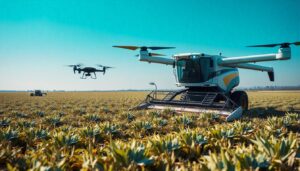How AI-Driven Smart Agriculture is Combating Climate Change and Food Insecurity
Agriculture is one of the sectors worst bitten by rising climate change challenges. Shifting weather patterns, uncertain rainfall, and increased floods and droughts have seen farmers fight crop yields from rising consistently around the world. Such elements are threatening food security worldwide and putting stress on a farm system already under pressure due to limited resources. However, innovations in AI are coming up with unique smart agriculture solutions that will not only improve the productivity of farming but also reduce the negative environmental impacts of farming.
The Impact of Climate Change on Agriculture
Farming has always been fundamentally linked to the patterns of the weather. Indeed, climate change is making agriculture planning increasingly challenging. Such extreme weather events as floods or protracted drought might totally destroy crops. Fluctuations in temperature and rainfalls affect soil quality and biodiversity, thus leading to other problems such as new pests, soil degradation, and low water availability. It is against these headaches that an efficient, adaptive, and sustainable farming system is needed.
This is where AI-driven smart agriculture cuts in; it presents a solution to the farmers as regards how they can adapt to changes in environmental conditions while optimizing resource use.
How AI is Transforming Agriculture
The use of AI in agriculture has turned farming into a smarter, more data-intensive, and effective process for using land, water, and energy. Smart agriculture uses AI-enabled tools such as machine learning, predictive analytics, drones, and sensors to monitor environmental variables and provide real-time insights to farmers. Some of the ways in which AI could change agriculture include:
- One of the main issues that farmers are facing today is the usage of water as efficiently as it can be within their power, especially in areas where this water source is increasingly becoming a scarce resource. AI-based irrigation systems are analyzing soils, weather forecast information, and the health of plants to apply exactly how much and when the water should be applied to crops, thus saving precious resources and not wasting them. Applying the right quantum of water at the right time, AI facilitates an increase in water-use efficiency besides maintaining or improving crop yields.
- Precision Farming Precision farming through some AI applications enables farmers to know more about their soil composition, nutrient levels, and growth of their plants, so farmers can make rational decisions on planting on time and where, the amount of fertilizer to apply, as well as the type of seeds to use. Through drones and sensors, farmers directly access real-time information about the conditions of their fields, a gateway to being able to make timely corrections to improve crop health and maximize yields. This ensures not only increased productivity but also avoided overuse of fertilizers and pesticides, which can harm the environment.
- Climate resilience crops AI can also be used to develop climate resilience crops. Using large plant genetic data and environmental conditions machine algorithms with crop performance, one can profile the traits that make some crops more drought resistant or pest tolerant or other environmental stresses. Such information is then utilized by scientists and farmers in the development of crop variation that can tolerate such climate-related stress in order to give smaller chances for crop failure, and this, together with many other factors, is a very significant driver of global food security.
- New weather patterns are leading to many pests and diseases, which can cause immense damage to crops. The smart agriculture solutions may include predictive analytics and image recognition technologies that can identify the early signs of pest infestation or plant diseases. Such knowledge enables the farmer to make timely actions such as targeted treatment in specific areas without resorting to generalized usage of pesticides. The targeted approach results in reduced use of harmful chemicals in general and reduces loss to crops while the balance of ecosystems surrounding the area is protected.
- High-precision crop yield prediction using artificial intelligence models: This AI model uses historical and real-time data inputs to foretell crop yields within a high degree of accuracy. This lets farmers better prepare for yields, whereby they could manage resources better and make informed decisions on market pricing and distribution. Governments and organizations in turn can better predict when shortages may arise, thus taking proactive steps toward preventing food insecurity.
- Sustainability and Environmentally Friendly Impact. A further key objective of smart agriculture is establishing more sustainable farming systems. In optimizing usage, whether it be water, fertilizer, or energy, AI contributes to reducing the carbon footprint from farming. Using solutions developed on AI grounds, soil health and biodiversity can be monitored, and practices promoting long-term soil fertility and lowering greenhouse gas emissions can be recommended. This leads to an advantage on the environment, hence making farming more resilient to impacts from climate.
The role of AI in anti-food insecurity movements
Food insecurity is one of the problems globally, especially in highly vulnerable regions to climate change. AI is likely to contribute to reducing food shortages since it enhances efficiency and reduces resources wastage while boosting yield levels for crops. Smart agriculture techniques provide fruitful support to farmers in developed and developing countries that offer a solution through adaptation in conditions for producing food, thus feeding a bulging population.

For example, AI-driven tools may outweigh lack of access to agricultural resources and information in developing countries, providing smallholder farmers with valuable insight into how to improve productivity. Mobile apps with AI can give real-time advice on weather patterns, soil conditions, and pest control, which are factors that can empower such farmers to make better decisions leading to higher yields.


